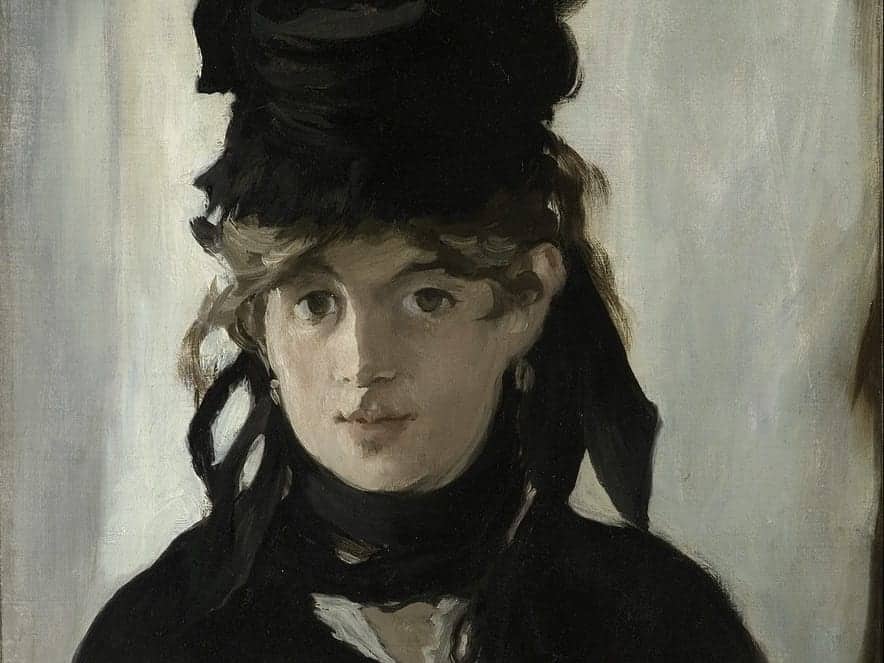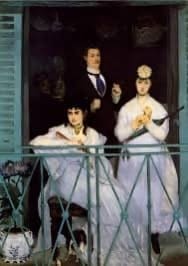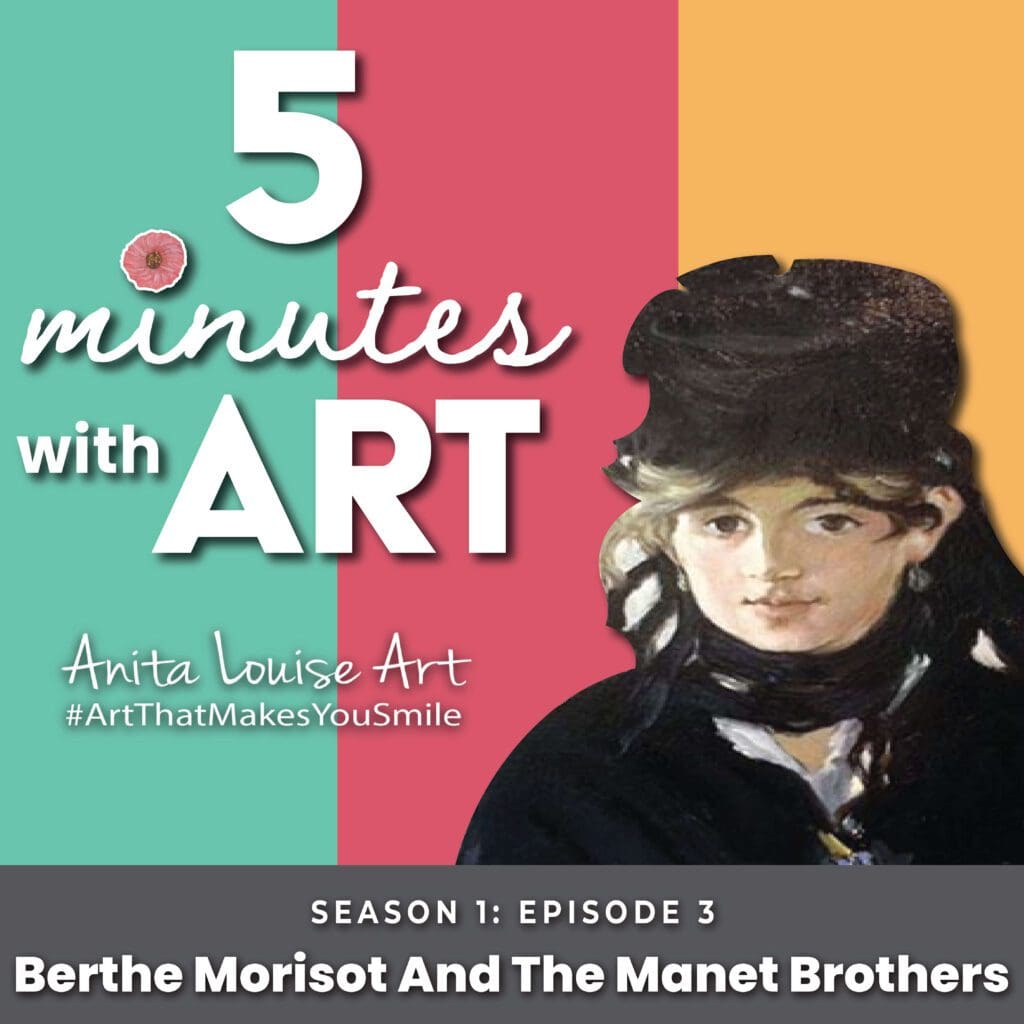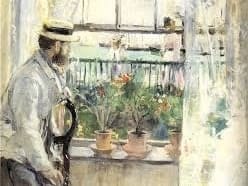One of the most interesting stories of the Impressionist artists is the relationship of Berthe Morisot and Edouard Manet and his brother Eugene Manet. All three were artists, but Berthe Morisot and Edouard Manet are now considered some of the most important impressionist artists.
Edouard Manet, Berthe Morisot, and Eugene Manet all lived in France in the mid-1800s. Both Edouard and Berthe are considered to be significant impressionist artists. Edouard met Berthe when he married Suzanne, his former piano tutor. Berthe and Edouard were lifelong friends, and she was considered his muse. Eventually, Berthe married Edouard’s younger brother Eugene, and they had one daughter named Julie.
Table of Contents
- The Intriguing Triangle: Berthe Morisot, the Manet Brothers, and Impressionist Love
- Frequently Asked Questions
- Related Questions
The Intriguing Triangle: Berthe Morisot, the Manet Brothers, and Impressionist Love
The entwined lives of Berthe Morisot and the Manet brothers, Edouard and Eugene, form one of the most captivating narratives within the Impressionist circle. Berthe Morisot, alongside Edouard Manet, ranks among the foremost figures of Impressionism.
Living in mid-19th century France, their artistic and personal journeys intersected profoundly. Edouard, initially married to his piano tutor Suzanne, encountered Berthe, forming a lifelong friendship marked by deep artistic respect; she became his muse and a central figure in several of his works.
The plot took a romantic turn when Berthe later married Edouard’s younger brother, Eugene, with whom she had a daughter, Julie.
The dynamic between Edouard, Eugene, and Berthe weaves a story of love, artistic inspiration, and societal intrigue — a rich and engaging tale that, surprisingly, has not yet been adapted into a film. Read on to discover more about the central characters in this romantic plot.
The Charming and Gregarious – Edouard Manet
Edouard Manet was born in 1832 into a bourgeoisie household in Paris, France. He was fascinated by painting from a very young age. His parents were not happy with his artistic interests. But he was eventually allowed to attend art school, where he studied many of the old masters in Europe.

He fell very short of his parent’s expectations for him and his life’s choices. His father was Auguste Manet, a high-ranking judge; his mother was Eugenie-Desiree Fournier, the daughter of a diplomat and goddaughter of the Swedish Crown Prince. By all accounts, they were an influential and well-connected family in Europe.
Edouard’s father wanted Edouard to follow him in his legal profession, but he refused and decided to pursue an art career. His father was worried that his son’s interest in the art would forever tarnish the family’s good name and reputation. So, his father continued to present to Edouard different options to guide him away from his pursuit of art.
In all those professions Edouard’s father presented to him. Edouard either failed at or refused to do. Eventually, his father accepted his chosen profession to become an artist.
It was after Edouard opened his art studio and started to paint professionally that he married Suzanne Leenhoff; Suzanne was an excellent pianist and has been hired by their father in 1851 to teach his sons to play the piano. Suzanne was about three years older than Edouard.
Things we know about Suzanne and Edouard’s relationship:
- Suzanne was older than Edouard and had been his piano tutor.
- When Edouard and Suzanne married, she had a 10-year-old son named Leon-Edouard Koella.
- Some say that Suzanne had an affair with Edouard’s father, Auguste.
- Because of this rumor, some historians believe the son was actually Edouard’s stepbrother and was the child of Edouard’s father and Suzanne and that Edouard married Suzanne to ensure the family name and reputation did not suffer.
- Others say that the son was Edouard’s. Before they were married, he had been romantically involved with Suzanne for over 10 years and kept this romantic relationship secret from his father.
- The birth certificate of Leon-Edouard gives Suzanne as the mother and Koella as the father. No one has been able to identify who Koella is.
- We know that Suzanne was not married when she gave birth to her son Leon-Edouard.
- Edouard could have cleared up this myth that Leon-Edouard was his son and not his step-brother or the son of another man, but Edouard never publically confirmed who Leon-Edouard’s father was.
We know that Edouard died in 1883 from locomotor ataxia, which was a side effect of syphilis. Syphilis is usually transmitted through sexual activity.

In speaking of Edouard’s death, Berthe Morisot wrote to her sister Edma about some of her feelings:
“These last days (of Edouard Manet dying) were very painful. Poor Edouard suffered atrociously. His agony was horrible, death in one of its most appealing forms, that I once again witnessed at a very close range. If you add to these almost physical emotions my old bond of friendship with Edouard, a entire past of youth and work suddenly ending, you will know that I am devastated.”
Berthe Morisot
Edouard Manet and Berthe Morisot Form a Lifelong Relationship.
Berthe Morisot was born in 1841 into a bourgeois French family. Her father was Edmé Tiburce Morisot, an eminent government official. Her father had also studied architecture at École des Beaux-Arts in France. Marie-Joséphine-Cornélie Thomas was Jean-Honoré Fragonard’s great-niece one of the most essential Rococo painters of his time.
Berthe Morisot was born into social and economic privilege. As was typical for her social class, Berthe and her sister Edma were tutored at home in art education.
It was one of these tutors. Joseph Guichard introduced Berthe and her sister Edma to the Louve Gallery. During this period of time, the Louvre Gallery had certain days when painters could come into the museum with their paints and easels to copy the artwork of the masters.
In 1868, Edouard Manet went to the Louve, where he met Berthe Morisot. As Berthe was single at this time, she would have been heavily chaperoned at all times. But despite this, they were able to form a lasting friendship.
We know that Edouard Manet was quite intrigued by Berthe. She sat for him, and he painted her many times. Berthe’s mother usually came with her as the chaperon when she modeled for Edouard Manet. She never modeled nude for him, but I am sure her mother must have watched what was going on and was extremely concerned. Her daughter was unmarried, having spurned marriage so that she could work full-time on her art.
Edouard Manet had a reputation in Paris for being a rebel. Though he would have been considered a gentleman, Luncheon’s paintings on the Grass (1862) and Olympia (1863) caused quite a stir in Paris society. Berthe’s parents would have known about his reputation and were probably very concerned about their daughter’s reputation with Edouard Manet.

We do not know if Edouard and Berthe ever had an intimate physical relationship. Still, from the paintings he painted of her, you can see the flirting taking place, especially in how he painted her eyes.
We can only suppose that Berthe’s mother did not really approve or was worried about the effect this relationship between Berthe and Edouard would have on her daughter’s social reputation. When Edouard Manet finally painted a portrait of his wife Suzanne, Berthe’s mother in speaking of Berthe’s relationship with Edouard Manet, said:
“He has made a portrait of his wife….I think it was about time”
Marie-Joséphine-Cornélie Thomas

Listen To Our Podcast About Berthe Morisot And The Manet Brothers below or by clicking here.
Relationship Between Edouard Manet and Berthe Morisot
The relationship between Edouard Manet and Berthe Morisot was complex and multifaceted, characterized by deep mutual respect and artistic admiration. Known aspects of their relationship include a strong bond of friendship and collaboration, with Morisot often serving as a muse and subject for Manet’s paintings.
Their interaction was personal and significantly influenced their artistic development and styles. While the exact nature of their relationship has been the subject of much speculation, it is clear that their connection profoundly impacted their lives and work.
Things we know about the relationship between Edouard Manet and Berthe Morisot:
- He painted her 12 times, more than any other person or subject he painted—more times than he ever painted his wife, Suzanne. Berthe was considered his muse.
- Many paintings she sat for would have been very controversial for their day, so Berthe’s reputation and standing in society could have been hurt. But this did not bother her as she continued to sit for him and be painted by him.
- After Berthe married Edouard’s brother Eugene, Edouard painted Berthe one last time. Her gold wedding ring is prominent in this painting, and her eyes have lost their flirtiness and mystery as in some previous paintings.
- The correspondence between Berthe Morisot and Édouard Manet shows warm affection.
- We know that Edouard Manet gave Berthe an easel as a Christmas present.
- Edouard Manet was handsome and gregarious. He was a man with a lot of charm, but yet, at the same time, he had this dangerous rebel streak. Precisely the kind of man that many women find attractive.
- Edouard and Berthe were not only in-laws but also lifelong friends who had a tremendous influence on each other’s art. Almost as soon as Berthe met Edouard Manet, she adopted more of his art impressionist style. Berthe influenced Edouard to use the style en Plein air, which is French for in the open air and was a departure from Edouard’s previous painting style.
Berthe Morisot and Eugene Manet Marry
Eugene Manet was born in 1833 and was the younger brother of Edouard Manet. The two were very close in age. Like his older brother, Eugene was also a painter, he never reached the fame or prestige of Edouard.
Eugene did serve in the French Army and was also trained as a lawyer. Instead of pursuing any of these careers, he decided to follow his older brother’s footsteps and become an artist.
It must have been Edouard who introduced Berthe Morisot and Eugene. We know that Berthe knew both of Edouard’s brothers.
Some have speculated that Berthe and Eugene’s marriage was convenient, but there is also evidence that they loved each other. It was Eugene who spent a lot of his time helping his wife with her artistic career. So, by all accounts, he seemed pleased to support her with her art.
Berthe and Eugene also had one daughter named Julie, who later became a painter. Julie is best known for her published diary called Growing up with the Impressionists. This book speaks about her memories of growing up in a home where Edouard Manet, Pierre-Auguste Renoir, Edgar Degas, Claude Monet, and Alfred Sisley frequently visited.
Things that we do know about Eugene and Berthe’s relationship:
- When Berthe married Eugene in 1874, Eugene was 41 years old, and Berthe was 33 years old. Both were quite a bit older, especially by the day’s standard. This was the first marriage for both of them.
- Berthe was adamant that the marriage would not change her art. So, despite being married and having one daughter, she was a prolific painter.
- Berthe was fortunate in that her marriage prevented her from worrying about money. This also allowed her to be able to concentrate on her art.
- Eugene really supported Berthe and the pursuit of her art.
- When Berthe went on art trips, Eugene often accompanied her and dabbled in art.
- Once Eugene got married, he focused on Berthe’s art, not his own art career.
- They had one child, Julie Manet, who would become an art collector, writer, and painter during her lifetime.
- Despite today being considered one of the most important impressionist artists, Berthe Morisot did not see much success during her lifetime.
One of Berthe and Eugene’s places they traveled to was the Cowes on the Isle of Wight in England. It was there they spent their honeymoon. Eugene and Berthe could be seen during the day, taking out their easels and paints and going out to paint the local scenery. Sometimes, she would also paint the view from where they were staying.
During their time in Cowes, she persuaded Eugene to be her model for a painting. She lovingly wrote to her sister Edma about how difficult it was to get Eugene to model for her. Berthe said:
“I began something in the sitting room with Eugène; poor Eugène is taking your place; but he is a much less accommodating model; he’s quickly had enough…“
Berthe Morisot

A three-way relationship between Berthe, Edouard, and Eugene Manet is a love story that is rarely told. The one thing in all this that we do know is that Eugene died before Berthe, and she was sad and distressed about his death. She died a few years later, leaving their daughter an orphan at age 16.
Berthe and Eugene seem to have had an excellent relationship, and she loved him deeply, especially later in their lives. Berthe, in writing to her brother, said this about her marriage to Eugene:
“I have found an honest and excellent man (Eugene Manet) who, I believe, sincerely loves me. I have entered into the positive life after having lived for a long time in by chimeras.”
Berthe Morisot
In Berthe’s own words, we learn that she finally found love in her relationship with Eugene Manet. Any love between Berthe and Edouard would have been an illusion or impossible. A marriage relationship between them would have been improbable as Edouard was already married to Suzanne.
Anita Louise Art is dedicated to art education, great artists, and inspiring others to find and create their art. We love art that uplifts and inspires. #ArtToMakeYouSmile! #ArtToMakeYouHappy!
If you want to see any of my art, you can find out more by clicking here. If you are interested in what inspires me and my paintings, you can discover more by clicking here.
We have a free newsletter and would love you to be part of our community; you can subscribe to the newsletter by clicking here. If you have any questions, I would be happy to talk to you anytime. You can reach me, Anita, by clicking here.
Subscribe to our Anita Louise Art YouTube Channel with great videos and information by clicking here.
Join us for our podcast “5 Minutes With Art.” Spend just 5 minutes a week with us to discover and learn about great art and artists. You can find out more about our podcast by clicking here.
Frequently Asked Questions
How did Berthe Morisot die?
Berthe Morisot died on March 2, 1895, in Paris, France. Her daughter Julie was ill with an illness similar to pneumonia, and Berthe was by her bedside. It was then that Berthe also contracted pneumonia, which led to her death. Julie was only 16 years old at the time and was left an orphan as both of her parents were now deceased.
What techniques did impressionists use?
There are quite a few techniques that impressionists use. Here are some of them:
Use of light – Impressionist art has a strong use of light in their art.
Short, thick strokes – The impressionists used short, thick strokes to capture the essence of their painting.
The illusion of movement on canvas – Brush strokes that are quickly applied can give the illusion of movement on the canvas surface.
Thick paint application – The paint is thickly applied on the canvas.
Complementary colors – The impressionists used complementary colors and vibrant color contrasts.
Color mixing on canvas – Instead of mixing the colors on the palette, many impressionists would mix the colors on the canvas. This then added to the paint strokes, looking almost like a broken color on the canvas.
What is the en plein air painting technique?
e en Plein air painting technique is French for “in the open air.” Impressionist artists used the en Plein air technique to describe how they would paint outdoors. They would capture the landscape through natural light or the light and colors as they saw them. The en Plein air technique was also applied to oil painting and watercolor.
Edouard Manet said of nature and colors: “There are no lines in nature, only areas of color, one against another.” – Edouard Manet
Who was Berthe Morisot?
Berthe Morisot (1841–1895) was a French painter and a key figure in the Impressionist movement. She was known for her delicate brushwork and light color palette, focusing on domestic life and portraits with a particular emphasis on the lives and experiences of women in the late 19th century.
What made Berthe Morisot unique among the Impressionists?
Morisot was unique for several reasons: she was one of the few women in the predominantly male Impressionist circle, and she brought a distinctly feminine perspective to her art. Her focus on domestic scenes and the intimate lives of women provided a contrast to the urban and leisure themes often depicted by her male counterparts. Her technique was also notable for its loose brushwork and the play of light and shadow.
What are some of Berthe Morisot’s most famous works?
Some of Morisot’s most famous works include “The Cradle” (1872), depicting a mother watching over her sleeping child, and “Summer’s Day” (1879), which captures women leisurely enjoying a day by the lake. “Woman at her Toilette” (1875-80) and “Reading” (1873) are other significant works that showcase her talent in portraying everyday life.
Did Berthe Morisot face challenges as a female artist?
Yes, Morisot faced significant challenges as a female artist in a male-dominated field. She had limited access to formal art education and public exhibitions, and her work was often marginalized or not taken as seriously as that of her male peers. Despite these obstacles, she managed to carve out a successful career and gain recognition for her contributions to Impressionism.
How has Berthe Morisot influenced modern art?
Berthe Morisot has had a lasting impact on modern art, particularly in how female artists are viewed and the representation of women’s lives in art. Her focus on domestic scenes and everyday moments opened the door for future generations of artists to explore similar themes. Morisot’s work has been celebrated for its innovation, technique, and contribution to the development of Impressionism, influencing both the art movement and the broader art world.
Related Questions
What Was The Focus Of Renaissance Art?
Renaissance art focused on the classics of Greece and Rome, humanist philosophy, and the study of the human figure. Realism was also an essential part of Renaissance art. The great artists of the Renaissance also became great anatomists and studied human beings.
By clicking here, you can learn more by reading What Was The Focus Of Renaissance Art?.
What Is The Importance Of Art From The Renaissance Period?
Renaissance art is essential as it was a time of rebirth and discovery. Artists like Leonardo da Vinci, Michelangelo, and Raphael were at the forefront of that change, creation, and discovery. Renaissance art has influenced art and artists for many centuries and continues to influence artists today.
By clicking here, you can learn more by reading What Is The Importance Of Art From The Renaissance Period?.
Early Renaissance Vs. High Renaissance Art Explained
Early Renaissance and High Renaissance are both periods of the art of the Renaissance era. The entire Renaissance era shared a lot of the same characteristics. The High Renaissance was dominated by three major artists: Leonardo da Vinci, Michelangelo, and Raphael.
By clicking here, you can learn more by reading Early Renaissance Vs. High Renaissance Art Explained.


One response to “Berthe Morisot, Manet Brothers – Love And Impressionist Art”
[…] can read more about their relationship by reading our blog Berthe Morisot and the Manet Brothers – Love And Impressionist Art by clicking […]